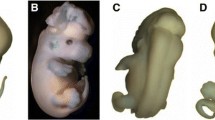Abstract
This paper reviews 50 years of progress towards understanding the aetiology and pathogenesis of neural tube defects (NTD) in the curly tail (ct) mutant mouse. More than 45 papers have been published on various aspects of curly tail with the result that it is now the best understood mouse model of NTD pathogenesis. The failure of closure of the spinal neural tube, which leads to spina bifida in this mouse, has been traced back to a tissue-specific defect of cell proliferation in the tail bud of the E9.5 embryo. This cell proliferation defect results in a growth imbalance in the caudal region that generates ventral curvature of the body axis. Neurulation movements are opposed, leading to delayed neuropore closure and spina bifida, or tail defects. It is interesting to reflect that these advances have been achieved in the absence of information on the nature of the ct gene product, which remains unidentified. In addition to the principal ct gene, which maps to distal Chromosome 4, the curly tail phenotype is influenced by several modifier genes and by environmental factors. NTD in curly tail are resistant to folic acid, as is thought to be the case in 30% of human NTD, whereas they can be prevented by myo-inositol. These and other features of NTD in this system bear striking similarities to the situation in humans, making curly tail a model for understanding a sub-type folic acid-resistant human NTD.
Similar content being viewed by others
Author information
Authors and Affiliations
Additional information
Accepted: 31 January 2001
Rights and permissions
About this article
Cite this article
van Straaten, H., Copp, A. Curly tail: a 50-year history of the mouse spina bifida model. Anat Embryol 203, 225–238 (2001). https://doi.org/10.1007/s004290100169
Issue Date:
DOI: https://doi.org/10.1007/s004290100169




